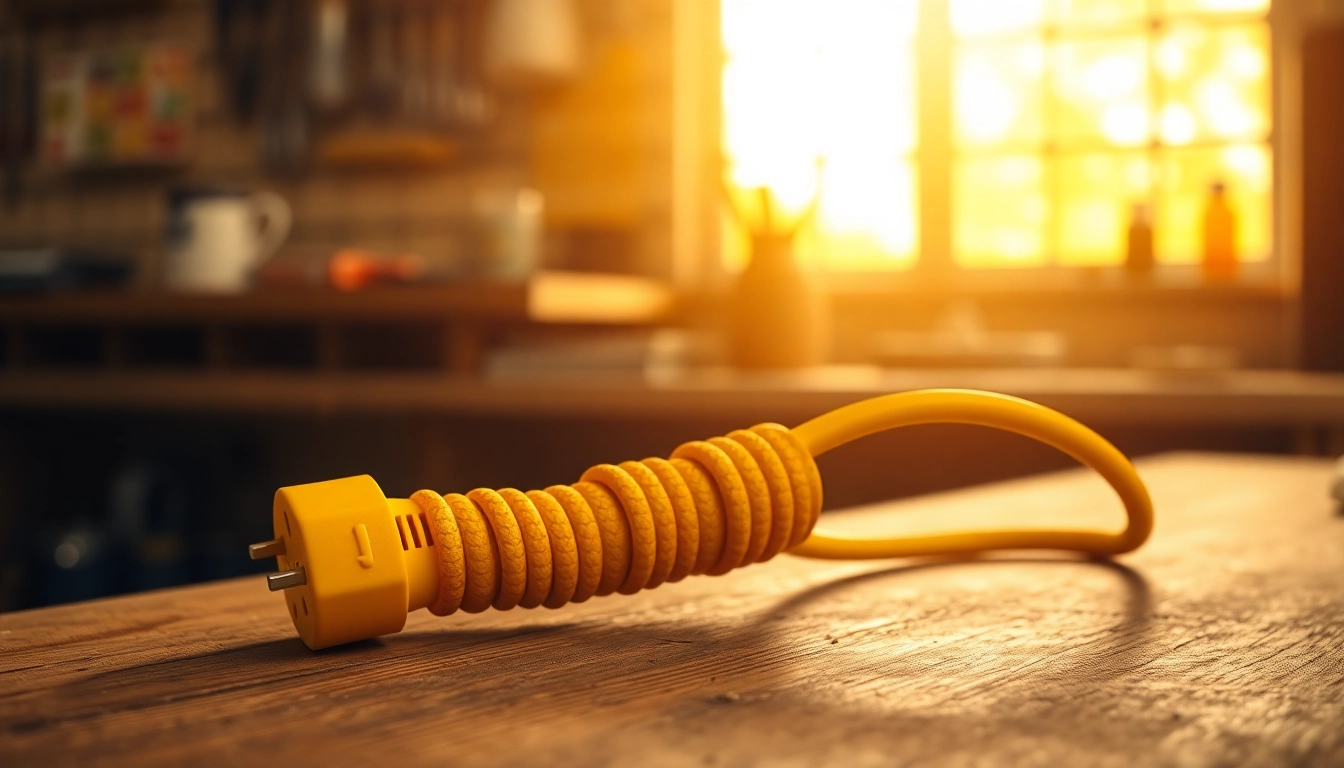In today’s world, electrical extension leads provide a reliable way to access power in areas without direct outlets. Among the different types available, the 15 amp extension lead has emerged as a popular choice for both home and professional use due to its capability to handle more power without overheating. This guide will explore the various facets of 15 amp extension leads, their safety standards, and maintenance practices, ensuring that you make informed decisions when purchasing and using them.
Understanding 15 Amp Extension Leads
What is a 15 Amp Extension Lead?
A 15 amp extension lead is an electrical cable designed to extend the reach of power from an outlet to various devices, handling a maximum load of 15 amps at 120 volts. These extension leads come equipped with appropriate connectors to safely deliver electricity over a distance, accommodating a range of applications from home entertainment systems to power tools in construction sites. Their robust design ensures that they maintain efficiency while minimizing the risk of currents exceeding safe levels.
Common Uses for 15 Amp Extension Leads
15 amp extension leads are versatile and find utility in various scenarios:
- Home Appliances: Ideal for powering high-demand devices such as refrigerators, air conditioners, and microwaves, particularly when outlets are not conveniently located.
- Outdoor Activities: Perfect for garden equipment like lawnmowers and hedge trimmers that typically draw more power.
- Construction Sites: Commonly used for portable tools and heavy machinery, ensuring builders have the power they need, where they need it.
- Event Settings: Useful for stabilizing power for audiovisual equipment at gatherings or outdoor events.
Key Features to Look For
When selecting a 15 amp extension lead, consider the following features:
- Gauge: The wire gauge indicates the thickness of the wire inside the extension lead. A lower gauge number (12 or 14) is typically preferred for higher power demands, as it reduces resistance and prevents overheating.
- Length: 15 amp extension leads come in various lengths, typically ranging from 10 to 50 feet. Longer cords are convenient but mitigate efficiency, as voltage drop can occur over extended distances.
- Material: Look for leads made with high-quality materials, such as heavy-duty rubber or thermoplastic, which can withstand abrasion and harsh weather conditions.
- Plug Type: Ensure the lead is equipped with the correct plug type for your devices, typically either NEMA 5-15 or C13 configurations.
Safety Standards for 15 Amp Extension Leads
Importance of Safety Ratings
Safety ratings are crucial when selecting an extension lead, as they ensure the product meets rigorous testing and quality standards. Look for UL (Underwriters Laboratories) listings or certifications from equivalent organizations, which signify compliance with safety regulations. For instance, a lead rated for 15 amps must be capable of sustaining this load without risk of fire or electrical shock.
Decoding Electrical Ratings
Understanding the electrical ratings on an extension lead will help you gauge whether it meets your needs:
- Amperage Rating: Indicates the maximum electrical current the lead can handle safely. A 15 amp rating means it is suitable for devices that draw up to 15 amps.
- Voltage Rating: Determines the maximum voltage the cord is designed to handle. The standard for most residential applications is 120 volts.
- Wattage Calculation: To determine the wattage, multiply the amperage by the voltage. For a 15 amp lead, the maximum wattage is 1800 watts (15 amps x 120 volts).
Best Practices for Usage
To maintain safety when using a 15 amp extension lead, remember these best practices:
- Avoid Overloading: Ensure that the total wattage of devices plugged into the lead does not exceed its rating (1800 watts for a 15 amp lead).
- Inspect Regularly: Regularly check the lead for fraying or exposed wire. Damaged leads pose serious risks and should not be used.
- Proper Connections: Ensure that connections are firm and secure. Loose connections can lead to overheating or electrical arcing.
- Use Appropriate Indoor/Outdoor Rated Leads: Ensure that the lead is rated for outdoor use if intended for such applications, providing added protection against moisture and sun damage.
Choosing the Right 15 Amp Extension Lead
Comparing Lengths and Gauges
Choosing the right length and gauge for your extension lead is essential for safety and efficacy:
- Length: A longer lead allows more flexibility but may reduce power efficiency due to voltage drop. If using devices that draw a high amperage, a shorter cord (less than 25 feet) is advisable.
- Gauge: As mentioned, a lower gauge represents thicker wiring. For instance, a 12-gauge extension lead is preferable for devices nearing the 15-amp threshold, as it can handle more power without overheating.
Outdoor vs. Indoor Applications
When selecting an extension lead, consider whether it will be used indoors or outdoors. Outdoor extension cords are designed to withstand environmental stresses such as moisture and UV radiation. These often include features such as:
- Waterproofing: Sealed connections and water-resistant materials will prevent damage from rain and spills.
- Color Coding: Brightly colored cords are easier to spot in outdoor settings, reducing the chances of tripping.
- Reinforced Connectors: Designed to resist bending and wear, extending the lifespan of the lead.
Recognizing Quality Brands
When investing in a 15 amp extension lead, consider reputable brands known for their reliability and safety. Some of the leading brands include:
- Husky: Offers a range of heavy-duty extension cords, particularly popular in the construction industry.
- Southwire: Renowned for high-quality electrical products, their extension leads are designed to withstand harsh conditions.
- Iron Forge Cable: Known for producing durable and reliable extension leads, often with an emphasis on industrial applications.
Maintenance Tips for Extension Leads
Ensuring Longevity and Performance
Maintenance is key to prolonging the life of your 15 amp extension lead. Here are some essential tips:
- Correct Storage: Always coil the lead properly to avoid damaging the wiring. Store in a dry area protected from extreme temperatures.
- Regular Cleaning: Wipe down the exterior with a damp cloth to remove dust and grime. Ensure that connectors are free from debris.
- Avoid Kinking: Never wrap the cord too tightly, as this can create breaks in the wire over time.
Storing Your Extension Lead Safely
Safe storage is essential to extend the life of your extension lead:
- Use Velcro Straps: Fasten the lead securely with straps to prevent tangles.
- Designated Storage Area: Keep your extension leads in a specific place to avoid misplacement and ensure they are always ready for use.
- Avoid Storing in High Humidity Areas: Store leads in areas with low humidity to avoid potential corrosion of connectors.
Troubleshooting Common Issues
If you encounter issues with your 15 amp extension lead, consider the following troubleshooting tips:
- Power Issues: If devices do not power on, check if the lead is plugged in securely and inspect for visible damage.
- Overheating: This could indicate overloading. Ensure the total ampage does not exceed 15 amps and remove excessive devices.
- Intermittent Power: This can occur from damaged plugs. Replace any damaged connectors immediately.
Buying Guide: Where to Find 15 Amp Extension Leads
Top Retailers to Consider
When looking to purchase a 15 amp extension lead, consider checking these popular retailers:
- The Home Depot: Offers a wide range of electrical products, including quality extension leads.
- Amazon: A comprehensive marketplace where you can find leads by various quality brands.
- Walmart: Features both in-store and online shopping options for electrical products.
Comparative Pricing and Offers
Pricing for 15 amp extension leads can vary significantly based on factors such as brand, length, and quality. On average:
- Standard 15 amp extension leads priced around $15 to $50 for lengths between 10 to 25 feet.
- High-end outdoor leads may go up to $100 or more based on added durability features.
Online Shopping vs. In-store Purchases
Both online and in-store purchases have their advantages. Online shopping offers the convenience of comparing multiple products easily, while in-store shopping allows for a tactile examination of the product before purchase. Ensure to read reviews and check ratings when shopping online for a more informed decision.



